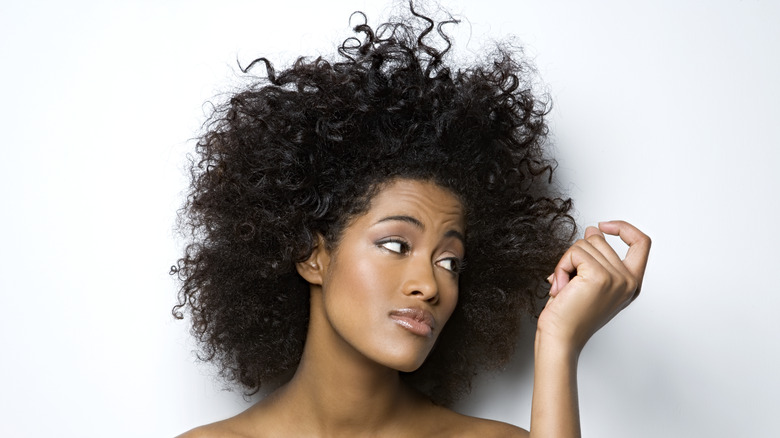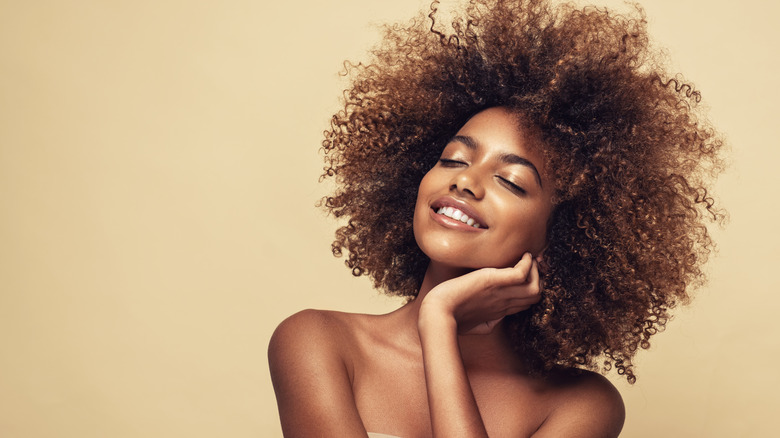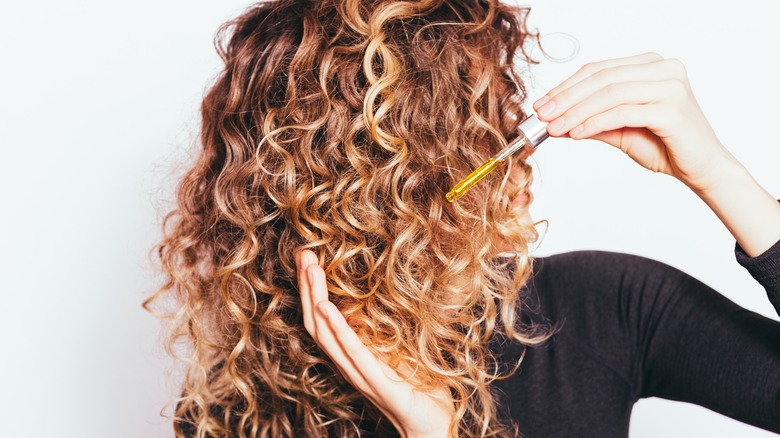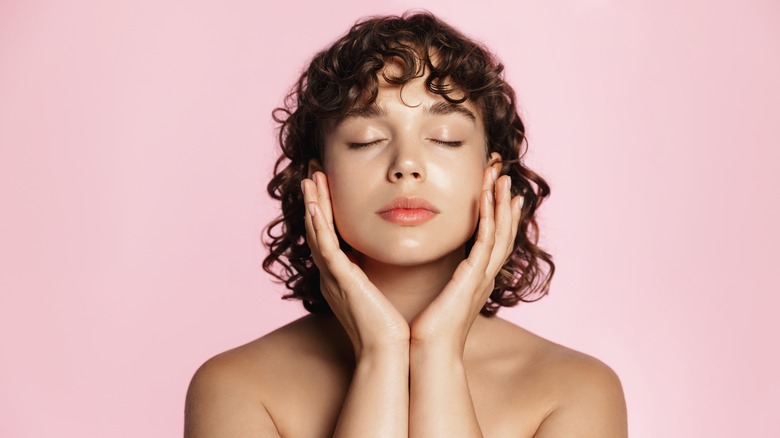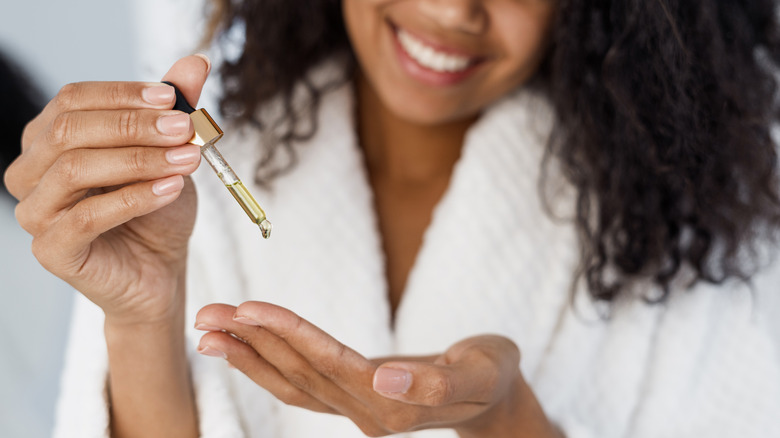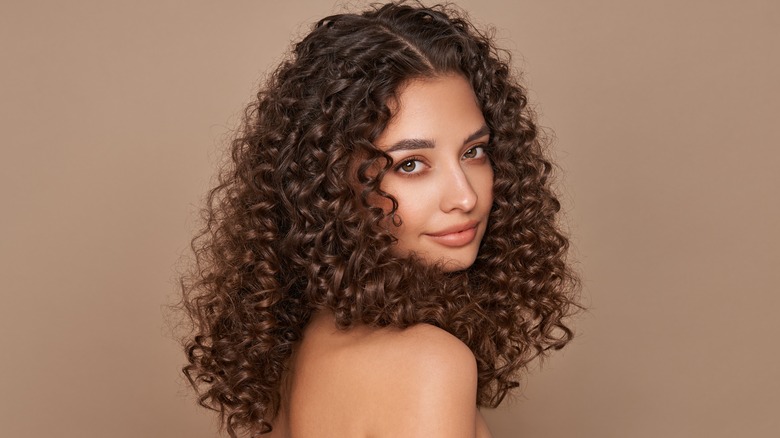Restore Your Natural Curl Pattern By Curl Training Your Hair
We may receive a commission on purchases made from links.
Many of us have fallen prey to easy ways to ruin your curly hair. Heat damage from curling irons, straighteners, or curling pins can wreak havoc on your natural curls. And it's not just heat damage that could make your curls less luscious. Some popular products could be secretly ruining your curly hair, too. Even the ways you wash your hair can affect how curly it is. For instance, scrunching too much shampoo into the middle and lower parts of your hair can make it more difficult for smooth curls to form (even if you use the curly hair method). "Always focus on washing directly at the scalp vs. agitating the mid-lengths and ends which can cause hair stress and extreme tangles," said hair expert Kerry E. Yates (per Bustle).
But even if you think your curls are too far gone to stand in the limelight, consider following these tips for restoring your hair to its former glory.
What is 'curl training'?
Curl training is taking steps to make your curls pop by following your natural pattern. The trend has grown popular across social media, but some people are still confused about what curl training entails. Curly hair care specialist and blogger Colleen Charney says curl training is all about "enhancing" your current curls. You aren't trying to force your hair to develop curls if you don't already have them. But if you have curly hair and are not happy with how it naturally looks, a few simple additions to your routine can highlight your natural patterns and limit the amount of frizz.
Think of it like your curls have forgotten how they are supposed to fall. "Curl training is restoring and reforming one's natural curl memory," BREAD Global Styling Director Shelby Samaria told InStyle. "[It's] refining and embracing one's curl memory to give the hair a more consistent look. You'll have more body and a more polished, cohesive look."
Can curl training completely reverse heat damage?
Unfortunately, even the most consistent curl trainers can't undo heat damage in its entirety. According to Dyson, heat damage breaks your hair's protein bonds and cuticles, which cannot be reversed. The only way to completely get rid of heat damage is to cut damaged hair off. Science can't bring back those protein and cuticle bonds.
"Once you have heat damage, the elasticity of your hair changes," Shelby Samaria tells InStyle. "When the hair stays straight after heat damage, it's because the heat has changed the shape of your natural hair's keratin strands." While prevention is the ideal way to address heat damage, you can't go back in time and pull the plug on all the straighteners or curling irons you have used.
However, if you let your hair grow back and avoid heat, curl training is a great way for maximizing your curls and keeping your hair healthy. Here's how to do it.
Get a haircut
It may feel counterintuitive, but the first thing you need to do when you commit to curl training is to head to your stylist and ask for a chop. As noted above, heat damaged hair can't be reversed. To restore your curls to their former glory, you'll need to start with hair that has been pretty much untouched by heat products, according to hair expert Shelby Samaria (via InStyle).
"The most important foundational factor would be to begin with a haircut," Samaria said. "Getting rid of any unhealthy hair will help embrace and encourage any curl to form. A haircut will also increase volume and add body to the hair." If starting with a chop isn't something you can commit to, All Things Hair advises to gradually cut off your damaged hair with consistent trims. These trims will seem less dramatic and lead to an end product just as voluminous and popping.
Prioritize moisture
Curly hair is naturally drier than other hair types. Your curls make it difficult for the oils on your scalp to reach the ends of your hair. Because of this, you'll need to make moisturizing your curls a top priority while you train them. Start paying attention to which shampoos you use since some can dry out your hair more than others. Also, please, please, please stop washing your curly hair every single day.
A great option for those looking for a curly hair-friendly moisturizing shampoo is the dpHue Apple Cider Vinegar Rinse, which is a cleanser that uses apple cider vinegar to gently balance your hair's pH and maintain the natural oils your curly hair needs. The product is designed with a nozzle that "allows direct access to your roots and doesn't leave a chemical itch like other shampoos [might]," according to Los Angeles-based hairstylist Gabriella Mancha (via Allure).
Do the twist
Once you are working with moisturized, non-heat-damaged hair, you can start adding more steps to your routine that may highlight your natural curls. Depending on your curl pattern, try twisting your curls with your fingers or in braids. Twisting your hair around your finger works to "embrace curl memory," per hair expert Shelby Samaria (via InStyle). Be sure to use product to help your curl stay in place.
Having curly hair doesn't mean that you can't style it. If you are doing your hair for an event and want to set your curls in place, this method has the added bonus of serving as curl training while you style. A curl gel like Pattern's Curl Gel or Strong Hold Gel will hold your curls in place while keeping them free from frizz.
With just a few changes to your usual routine, you can curl train your hair to make your locks the bounciest they can be.
